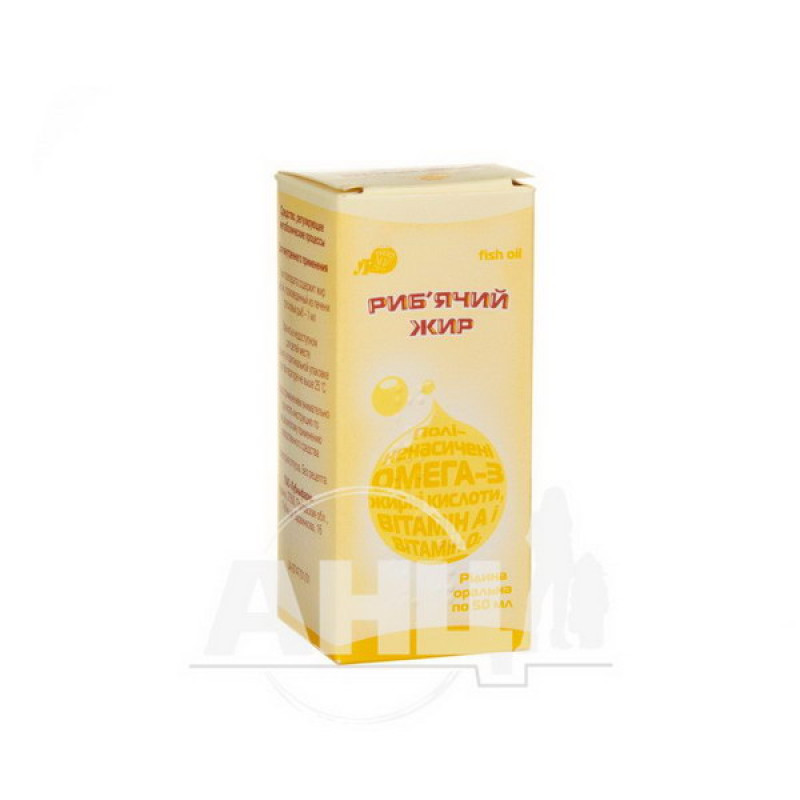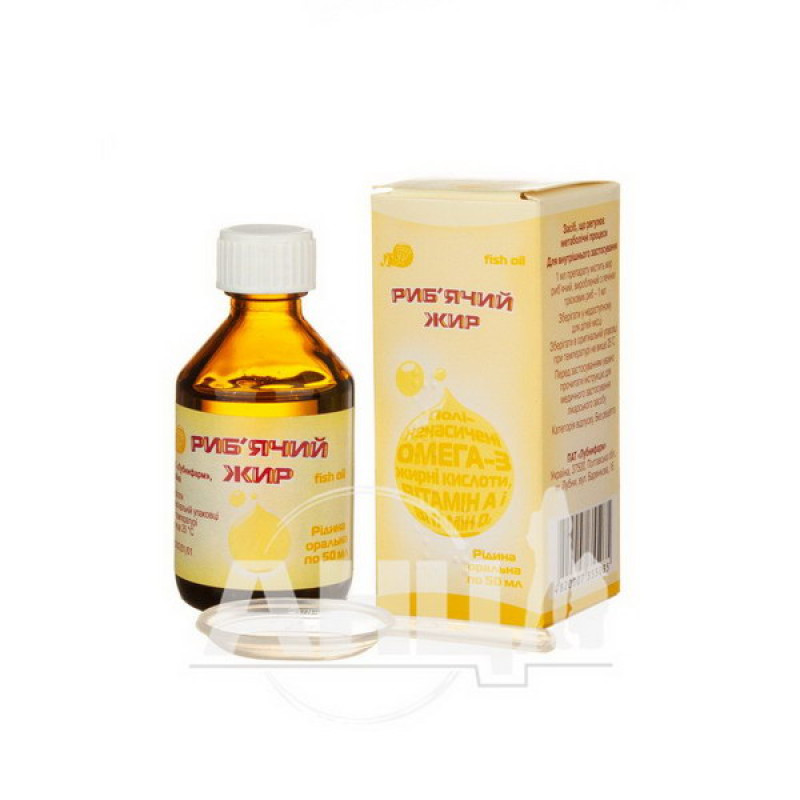Fish oil liquid oral bottle 50 ml

Translation of the instructions can be
FISH OIL oral liquid 50 ml, oral liquid 100 mlInstruction
For medical use of the medicinal product
Fish oil
(Oleum jecoris aselli)
Composition:
Active ingredient: fish oil, produced from the liver of cod fish;
1 ml of the drug contains fish oil, produced from the liver of cod fish - 1 ml.
Dosage form.
Oral liquid.
Main physicochemical properties: transparent oily liquid from light yellow to yellow in color with a specific odor.
Pharmacotherapeutic group.
Drugs that regulate metabolic processes.
PBX code A11J C.
Pharmacological properties.
The composition of the drug fish oil includes vitamin A (retinol), vitamin D2 (ergocalciferol), eicosapentaenoic acid, eicosatetraenoic acid, doxahexaenoic acid. The active ingredients of fish oil are polyunsaturated omega-3 fatty acids, vitamin A and vitamin D2. Omega-3 polyunsaturated fatty acids (eicosapentaenoic acid (EPA) and doxahexaenoic acid (DHA)), which are found in significant quantities in cod liver oil, have the following biological effects: DHA is necessary for the normal development of the brain, nervous system and retina of the child; EPA is a precursor of biologically active molecules - eicosanoids, which include thromboxane, leukotrienes, prostacyclins and prostaglandins. Eicosanoids - derivatives of saturated arachidonic acid, differ significantly in biological effect from eicosanoids - derivatives of EPA. Thus, thromboxane (TXA2) is formed from arachidonic acid, which has a pronounced vasoconstrictor effect, while in TXA2, formed from EPA, this effect is practically not expressed. Prostaglandins are derivatives of arachidonic acid, much more active than prostaglandins-EPA derivatives. This explains the decrease in the activity of the nonspecific inflammatory reaction when taking a sufficient amount of essential omega-3 polyunsaturated fatty acids. Omega-3 polyunsaturated fatty acids are precursors of some enzymes, change the physical properties of cell membranes, being part of phospholipids, and are directly involved in the process of gene transcription and in the process of binding protein molecules to cell membranes. The use of fish oil, which contains omega-3 polyunsaturated fatty acids, leads to a decrease in the level of triglycerides, cholesterol, low-density lipoproteins and very low-density lipoproteins, the predominance of the vasodilator effect over the vasoconstrictor effect, an increase in the elasticity of blood cell membranes, a decrease in platelet activation and chemotaxis, which reduces blood viscosity and the risk of thrombosis. These properties improve microcirculation, especially in vessels affected by atherosclerosis.
Clinical characteristics.
Indication.
Treatment of hypo- and avitaminosis A, eye diseases (retinitis pigmentosa, xerophthalmia, hemeralopia, keratomalacia), systemic therapy of skin and mucous membrane lesions, rickets, hypotrophy, acute and chronic respiratory diseases, inflammatory and erosive lesions of the digestive tract, urinary tract, acceleration of wound healing and bone fracture healing; prevention of atherosclerosis and thrombosis, restoration of normal coagulation after thrombosis.
Contraindication.
Hypersensitivity to the components of the drug; idiopathic hypercalcemia; hypercalciuria; active forms of pulmonary tuberculosis; acute and chronic liver or kidney diseases; nephrourolithiasis; chronic pancreatitis; hypervitaminosis D; sarcoidosis; prolonged immobilization; thyrotoxicosis; blood clotting disorders; all disorders associated with bleeding; cholecystitis; acute pancreatitis.
Interaction with other drugs and other types of interactions.
When using the drug simultaneously with other medications containing vitamins A and D, there is a possibility of developing hypervitaminosis.
With extreme caution, Fish Oil should be used simultaneously with drugs that affect blood coagulation. Interaction with acetylsalicylic acid or other nonsteroidal anti-inflammatory drugs (NSAIDs) may also be observed. Signs of such interactions may include nosebleeds, hematuria, melena. Very rarely - vomiting with blood, hemoptysis. In such cases, it is recommended to immediately discontinue use of the drug.
The activity of vitamin D may be reduced when used simultaneously with anticonvulsants or barbiturates.
When used simultaneously with estrogens, the risk of hypervitaminosis A increases. Vitamin A reduces the anti-inflammatory effect of glucocorticoids.
Application features.
When taking fish oil, special caution should be exercised by patients taking anticoagulants (e.g., warfarin); with heart disease, acute and chronic diseases of the gastrointestinal tract, gastric and duodenal ulcers, hypothyroidism; and elderly patients.
It is not recommended to use the drug together with other vitamin preparations containing vitamins A and D to avoid overdose of these vitamins.
If the drug is prescribed in courses, it is necessary to regularly conduct laboratory monitoring of blood coagulation parameters (every 2-3 months).
It is recommended to stop taking the drug at least 4 days before surgery or other surgical procedures.
Due to the antithrombotic effect of the drug, its use during pregnancy is possible only with the permission of a doctor and after a careful assessment of the risk / benefit ratio. During breastfeeding, the drug can be used after consulting a doctor.
The ability to influence the reaction speed when driving vehicles or other mechanisms.
The use of the drug does not affect the ability to drive or operate other mechanisms.
Method of administration and doses.
The dosage of the drug is selected individually by the doctor. Usually, adults are recommended to take 1 tablespoon 2-3 times a day. Children from 4 weeks of age are prescribed 3-5 drops 2 times a day, gradually increasing the dose to ½-1 teaspoon (2.5-5 ml) per day. Children under 1 year old - 1 teaspoon (5 ml) per day, up to 6 years old - 1 teaspoon (5 ml) 2 times a day, from 7 years old - 1 teaspoon (5 ml) 3 times a day.
It is recommended to use the drug in courses (2-3 months). After 2-3 months of use, it is necessary to monitor the parameters of the blood coagulation system and, depending on the result, continue the course of treatment (after consulting a doctor).
Children.
The drug is used in pediatric practice.
When using the drug, it is necessary to adhere to the specified doses.
Overdose.
With prolonged use of the drug, drowsiness, lethargy, headache, nausea, vomiting, pain in the bones of the lower extremities, bone demineralization, increased body temperature, increased sweating, and skin rashes may occur.
Treatment: symptomatic, drug withdrawal, restriction of calcium intake into the body with food.
Adverse reactions.
On the part of the immune system: allergic reactions;
from the vascular system: nosebleeds, increased bleeding from wounds or abrasions;
From the digestive tract: minor stomach upsets, which can be alleviated by reducing the dose; diarrhea, exacerbation of chronic cholecystitis, pancreatitis. With prolonged use of the drug in high doses, the patient's exhaled air may smell slightly like fish.
If any adverse reactions occur, you should stop using the drug and be sure to consult a doctor.
Expiration date.
1 year 6 months.
Storage conditions.
Store in original packaging at a temperature not exceeding 25 degrees Celsius.
Keep out of reach of children.
Packaging.
50 ml or 100 ml in a bottle; 1 bottle in a cardboard pack;
50 ml or 100 ml in a jar; 1 jar in a cardboard pack.
Vacation category.
Without a prescription.
Producer.
PJSC Lubnyfarm.
Location of production and its address of place of business.
Ukraine, 37500, Poltava region, M lubny, Barvinkovy St., 16.
There are no reviews for this product.
There are no reviews for this product, be the first to leave your review.
No questions about this product, be the first and ask your question.






